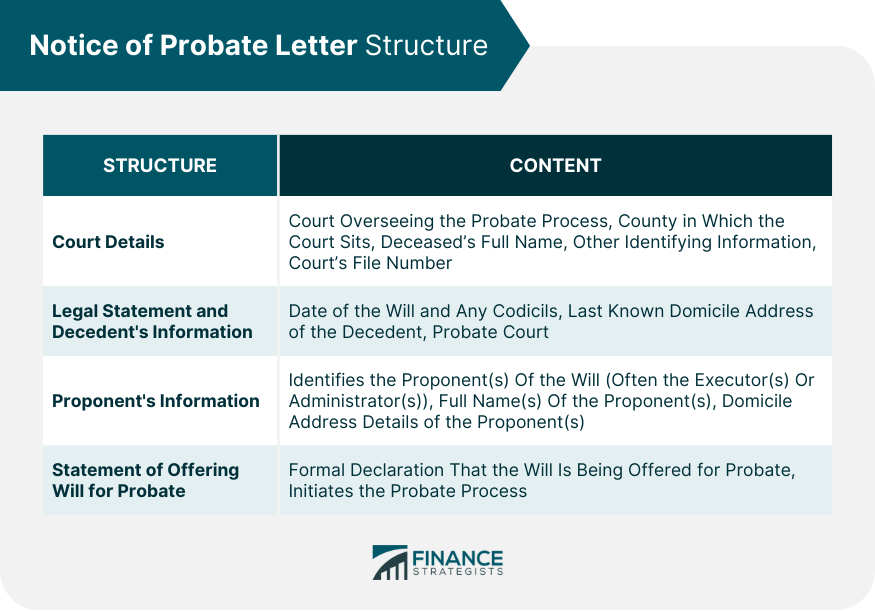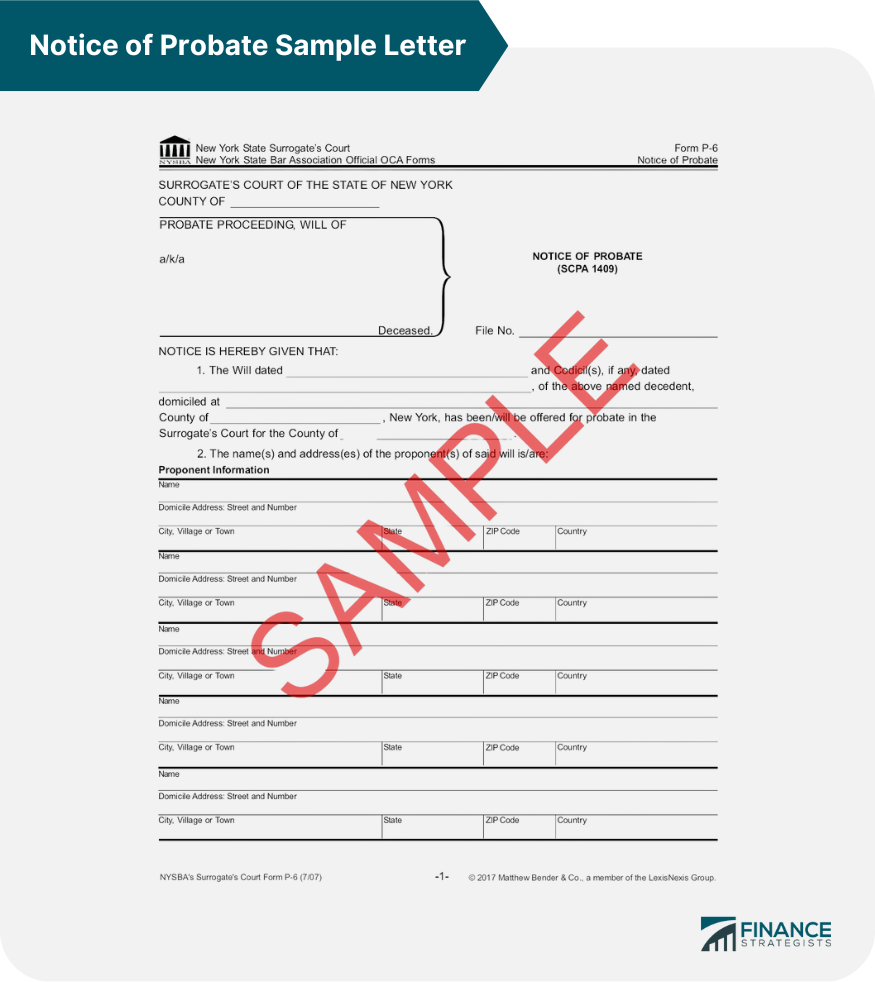A Notice of Probate is a vital legal document sent by an estate's executor or administrator after a person's death. It signals the start of the probate process, necessary for settling the deceased's estate, whether a valid will exists or not. The notice maintains transparency and fairness, allowing all potential claimants the chance to express claims or contest the will. It also provides legal protection to the executor or administrator, demonstrating due diligence in notifying all concerned parties. Usually, beneficiaries named in the will, heirs-at-law (inheritors under state law without a will), and potential creditors receive the notice. Depending on the jurisdiction, it may also need to be published in a local newspaper to reach unknown creditors or other interested parties. The notice should start by identifying the court overseeing the probate process followed by the county in which the court sits. The Probate Proceeding Information section usually includes the deceased's full name, other identifying information, and the court's file number. This section commences the formal announcement of probate, including the date of the will and any codicils. It then provides the last known domicile address of the decedent and specifies the probate court. The proponent(s) of the will—often the executor(s) or administrator(s)—are identified next. Their full name(s) and domicile address details are listed. Here, a formal declaration is made that the will is being offered for probate, which sets the probate process into motion. While every jurisdiction has its own specific requirements, a standard Notice of Probate should include all the key components discussed above. Below is a sample of Notice of Probate Letter from New York State Surrogate’s Court. It's recommended to seek legal guidance when drafting a Notice of Probate to ensure it aligns with state and local laws and contains all necessary information. When dealing with legal documents, precision and clarity are not optional—they are mandatory. This is particularly true for a Notice of Probate, as inaccuracies can lead to substantial legal complications. Providing incorrect or misleading information in a Notice of Probate can lead to delays in the probate process, potential legal disputes, and even personal liability for the executor or administrator. Given the potential for errors and their associated risks, seeking legal advice is strongly advised when preparing a Notice of Probate. A knowledgeable attorney can ensure the document is accurate, comprehensive, and legally sound. Each person or entity with a potential claim or interest in the estate should be identified and notified. Failure to include a beneficiary or creditor can result in delays, disputes, and potentially even legal action against the executor or administrator. Make sure to compile a comprehensive list and double-check the accuracy of all names and addresses. While it's not necessary to itemize every asset in the Notice of Probate, you should provide a general description that gives beneficiaries and creditors a clear understanding of the estate's value and complexity. This helps interested parties to assess their potential claim and decide whether to take further action. A crucial aspect of the Notice of Probate is informing creditors of the timeframe within which they must file claims against the estate. Neglecting to specify this deadline clearly and correctly may not only confuse creditors but can also leave the estate vulnerable to late claims. Always consult local laws to determine the appropriate timeline for filing claims, and clearly state this in the notice. Some other mistakes include using incorrect legal terminology, failing to serve the notice correctly, or not keeping a record of notices sent. To ensure the probate process runs smoothly, it's wise to seek the advice of an experienced estate planning attorney who can help avoid these pitfalls. Every jurisdiction has specific rules and regulations regarding how a Notice of Probate should be sent, including the methods of delivery and the timeframe. Let's look at the most common requirements. Typically, the law requires the Notice of Probate to be sent via certified mail, with a return receipt requested. This offers proof that the notice was sent and received. The Notice of Probate should be sent as soon as possible after the probate process begins. The exact timing may vary depending on local laws, but it usually happens within a few weeks after the will is admitted to probate. Certified mail is usually the preferred method. However, in some cases, a published notice in a local newspaper or a personal service, such as delivery by a sheriff, may also be necessary. The Notice of Probate is a fundamental legal document, setting the course for the probate process post a person's death. It ensures transparency and affords beneficiaries, heirs, and creditors the opportunity to assert their interests. Its structure typically includes court details, legal statements, information about the decedent and proponent, and a declaration of offering the will for probate. Precision and clarity are critical to prevent legal complications and misinformation can lead to liability for the executor or administrator. Common pitfalls include incomplete beneficiary or creditor information, poor description of the estate, and failure to specify claim deadlines. Legal consultation is advised to avert such issues. The notice should be sent as early as possible, typically via certified mail or other jurisdiction-specific methods. Understanding these guidelines can ensure a smoother probate process and protect the rights and interests of all parties involved.Overview of Notice of Probate
Notice of Probate Letter Structure
Court Details
Legal Statement and Decedent's Information
Proponent's Information
Statement of Offering Will for Probate

Notice of Probate Sample Letter

Importance of Precision and Clarity in a Notice of Probate
Legal Implications of Misinformation
Importance of Legal Consultation
Common Mistakes in a Notice of Probate
Incomplete Beneficiary and Creditor Information
Inadequate Description of the Estate
Failure to Specify Deadlines for Claims
Other Common Mistakes
Guidelines for Sending a Notice of Probate Letter
Legal Requirements for Sending a Notice
When to Send Notice of Probate
Recommended Methods for Sending the Notice
The Bottom Line
Notice of Probate Sample Letter FAQs
Yes, making mistakes in a Notice of Probate can lead to serious consequences. These can range from delays in the probate process to potential legal disputes, and even personal liability for the executor or administrator. Hence, it's crucial to ensure accuracy and completeness in the Notice, and consulting with an experienced estate planning lawyer is highly recommended.
Most law offices, legal resource websites, and sometimes local courts provide Notice of Probate Sample Letters. Always ensure the sample complies with local laws and regulations.
A Notice of Probate Sample Letter can be used as a reference when you're preparing to send a Notice of Probate. It is especially useful if you are unfamiliar with the required format and content.
Yes, you can write your own Notice of Probate, but a Sample Letter can guide you in ensuring that all necessary details are included. Consultation with an estate planning lawyer is strongly advised.
A Notice of Probate Sample Letter should include details about the Surrogate's Court, the deceased, the proponent of the will, a formal announcement of probate, and acknowledgment of the relevant local statute, among other key details.
True Tamplin is a published author, public speaker, CEO of UpDigital, and founder of Finance Strategists.
True is a Certified Educator in Personal Finance (CEPF®), author of The Handy Financial Ratios Guide, a member of the Society for Advancing Business Editing and Writing, contributes to his financial education site, Finance Strategists, and has spoken to various financial communities such as the CFA Institute, as well as university students like his Alma mater, Biola University, where he received a bachelor of science in business and data analytics.
To learn more about True, visit his personal website or view his author profiles on Amazon, Nasdaq and Forbes.











